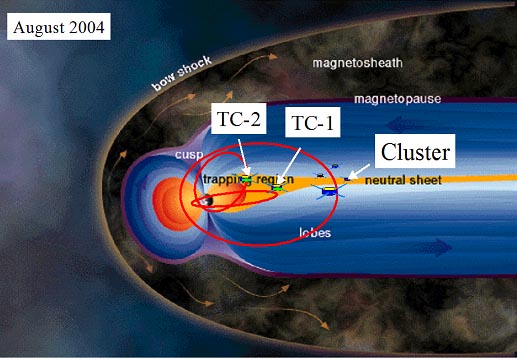Unique Insights - Double Star
Unique Insights
Planet Earth is continually subjected to a bombardment of energetic particles originating 150 million kilometres away in the Sun. Most of the particles arrive in the solar wind, a continuous stream of protons and electrons that flows past our planet. From time to time, enormous explosions known as coronal mass ejections may blast billions of tonnes of material into space at such high speeds that they reach the Earth in only a few days.
Fortunately, the Earth's magnetosphere usually protects the planet from the cosmic onslaught, forcing the solar wind to flow around it like an island in a stream. However, the magnetic bubble can be severely compressed by coronal mass ejections and particles can break through the defences at two weak points in the defences, known as the polar cusps.
Particles that leak into the magnetosphere may eventually spiral down the magnetic field lines towards the Earth, generating the spectacularly beautiful, but harmless, polar auroras. In contrast, other phenomena, such as magnetic storms, can have serious consequences for human activities - including power cuts, damaged satellites and communication blackouts.
 |
|
Double Star and Cluster orbits in August 2004 |
Although some important insights into the physical processes taking place in near-Earth space have already been provided by the Cluster quartet, the additional perspectives offered by the two Chinese satellites will significantly enhance our understanding of the interaction between the magnetosphere and the solar wind.
Whereas the Cluster spacecraft orbit between 19,000 and 119,000 km from Earth, periodically sweeping in and out of the magnetosphere, the Double Star duo will study regions closer to home. For example, in August 2004, when Cluster is flying far down the magnetotail, Double Star will be able to examine magnetospheric processes and activity taking place nearer to the Earth (see figure). Six months later, when Cluster is flying across the bow shock, the turbulent boundary between the magnetosphere and the solar wind, Double Star will be able to study activity at the cusps and close to the magnetopause.
A typical example of how both missions will interact is the study of the substorms that are produced when particles pick up energy and are accelerated towards the planet's poles, creating very bright auroras. Cluster was designed to study the mechanisms that produce these substorms far away in the magnetotail. However, a few years ago, some scientists suggested that the substorms might be generated closer to the Earth, in regions that can best be studied by Double Star. The joint mission will enable both hypotheses to be tested.
Similarly, while Cluster is flying at high altitude through the polar cusps - funnel-like openings in the magnetosphere above the magnetic poles - Double Star will be able to conduct simultaneous studies at lower altitudes. This will enable scientists to study in much greater detail the 'doors' used by electrically charged particles from the solar wind to descend into Earth's upper atmosphere. "Space is very big, but the four Cluster satellites are very close to each other, only a few hundred kilometres apart" explained Escoubet. "Although this enables us to observe small regions in great detail, we need more satellites to study the magnetosphere on a larger scale. By flying similar instruments simultaneously in complementary orbits on board Double Star, we expect our understanding of the Sun-Earth connection to improve substantially."
- Removed a total of (2) align=center.
- Removed a total of (1) border attribute.
- Removed a total of (1) cellpadding attribute.
- Removed a total of (1) cellspacing attribute.








































 Sign in
Sign in
 Science & Technology
Science & Technology